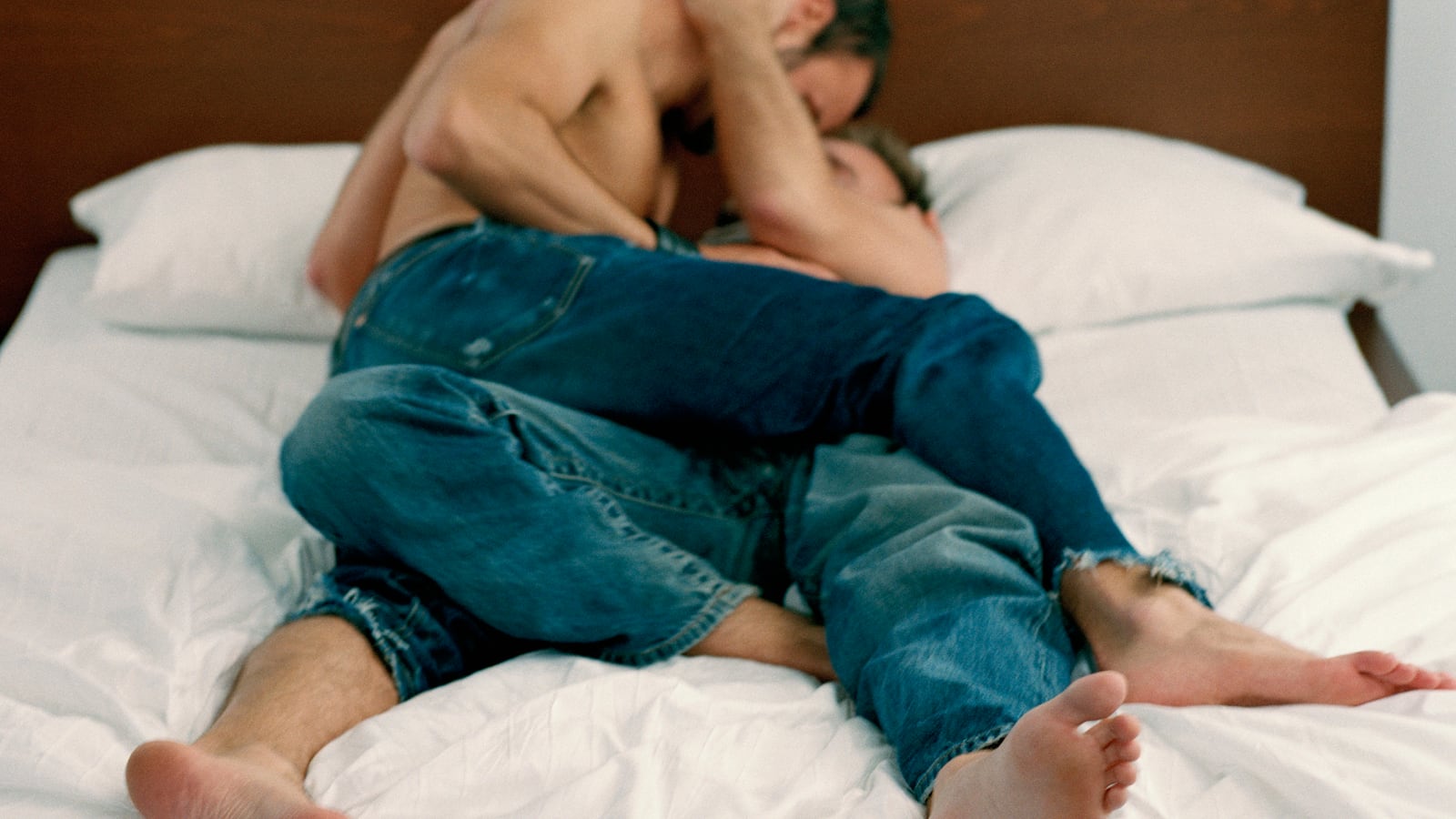Looking for love, but not an STD? Get off the phone and into a gay bar.
So suggests new research published today in the journal Sexually Transmitted Infections. Epidemiologists from the Los Angeles LGBT Center, UCLA and Los Angeles Department of Public Health conducted a massive study of 7,184 self-identified HIV negative gay and bi-curious men who checked in at a specific sexual health center in Los Angeles, between 2011 and 2013.
Researchers wanted to see if the efficiency of geosocial networking phone apps—sex on demand—would increase the rates of sexually transmitted infections (STIs) and HIV for men who met via hookup apps, compared to those who met in person or through more antiquated online sites like Manhunt or Craigslist. It seems it does, according the findings, although only for certain diseases.
The research shows that men who met sex partners via app had a greater incidence of gonorrhea (25 percent more) and chlamydia (37 percent more) compared to clinic attendees who met the old fashioned way: bars/clubs; the street; private sex party; bathhouse; gym; or circuit parties, or the more recent old fashioned way: online dating sites. It had no effect on rates of HIV or syphilis.
Some of what they found, we already knew.
First, previous research out of California has shown that gay men are more likely to engage in riskier sexual behavior—more partners, less protection—when they meet online vs. real life. A 2006 meta analysis found that unprotected anal sex was 68 percent more prevalent with partners who met online rather than offline. Online paramours are also over three times as likely to have anonymous sex and have nearly twice the number of sexual partners.
Men seeking men aren’t the only online group that engages in riskier sexual behavior, though. See “dating” app Tinder. People, regardless of sex, who sleep with new or multiple partners—random sybaritic sexual encounters being sort of the whole point to most hookup apps—are obviously more likely to acquire STIs.
Second, hookup apps are really popular. Grindr, the first gay hookup app, was launched five short years ago. Now cruisers can choose between apps like Scruff, Jack’d, Hornet, and MISTER. But Grindr is still the most popular among them, with five million active monthly users in 192 countries exchanging 38 million messages every day. There are over 2 million users in the U.S. alone.
With these numbers, it should come as no surprise that the majority of men in the study used an app to meet other men for sex. To break it down: 34 percent met sexual partners only in real life; 30 percent online or in person; and the largest proportion, 36 percent, used a smartphone app, either alone or in conjunction with other methods. The most devoted app users were under 40 years old, white, had a college degree, and were more likely to use cocaine and ecstasy than their less technophilic counterparts. Almost 2/3 of Grindr’s users are under 30 years old—an age group most at risk for Chlamydia and Gonorrhea infections generally, according to the CDC.
Why was there no increased risk for HIV? Matthew Beymer, epidemiologist and the study’s lead author, couldn’t be sure, but explained in an email that it might have something to do with sample size: “At the LA LGBT Center, we typically diagnose about 30 new HIV infections per month, but we diagnose approximately 120 new Chlamydia infections and 120 new Gonorrhea infections...There may still be an association between apps and HIV, but we may not have had the power to detect it given the lower incidence of HIV when compared to other STIs.”
Though the study was large, it does target a specific population: men going to a sexual health clinic. They might have different sexual habits than men who don’t check in at these health centers. And because the studied men were from gay-friendly LA, we can’t be sure that gay men in more rural or suburban areas with less opportunity for real life encounters would have the same elevated risk.
Despite the study’s limitations, the authors suggest health officials, hookup apps, and their users should make a better effort to push prevention. "Prevention programs must learn how to effectively exploit the same technology, and keep pace with changing contemporary risk factors for STI and HIV transmission," they wrote.
Health officials in California’s San Mateo County are on it. Though the area is just south of San Francisco, it has no real gay scene, making it difficult to reach men through traditional methods. Workers there came up with a clever solution to knocking on the closet door, going so far as to create at least two fake Grindr accounts using doctored stock photos to catfish men looking for love (or something like it). Men reeled in by the health department’s well-intended deceit are treated to “risk reduction information and referrals," according to Darryl Lampkin, who oversees the program. In other words:
Guy: Hey, I’m Brad. Wanna play?
San Mateo: You should really get tested for HIV and STDs.
It might not be a bad idea, academically speaking, but is it social media used for good or a deceptive encroachment with the potential to undermine the group’s credibility?
At MUSED, an online magazine for Black gay men, Joel Jenkins argues the effort strips men of their personal agency. He writes: “I wonder if this is another way that vulnerable communities are running into another form of exploitation. Exploitation from well-meaning agencies whose mission is to offer help is counterproductive. It’s one thing for an outreach worker to create a profile on a social media app and engage the community on a ‘virtual’ one-on-one basis. It’s a completely different matter to launch an initiative like the one in San Mateo. We have to value the personal agency of whomever we intend to help before we can ever imagine effectively counting on successful health outcomes.”
Whatever the case, it’s working. Since the Grindr outreach began in October 2012, the county’s health department increased the number of overall contacts made with men who have sex with men fivefold to 305 in the six months from October 2012 to March 2013. There is no data yet suggesting this actually resulted in less risky sexual behavior.
AIDS activists in nearby Marin County have scooped up the idea, and in January started posting fake profiles on Grindr, Scruff, and Growlr to reach a younger demographic. "It's a challenge in Marin when you don't have a gay bar or gay Pride day," Andy Fyne, manager for the group Marin AIDS Project, was quoted saying in The Bay Area Reporter. The group also posted to Craigslist: with the headline, "Do you like to bareback?" Eager clickers were treated to a cutesy: "No judgment from me," and the organization’s contact information.
For their part, hookup apps say they are committed to promoting safe sex. Responding to a request for information on their prevention efforts, a Grindr spokesman sent a fact sheet detailing recent partnerships with HIV prevention and awareness organizations. It said Grindr “strongly encourages our users to engage in safe sex practices, get tested and know their HIV status,” and pointed to the website’s health section with resources for testing.
In November, the dating geosocial app for men over 30, MISTER, hooked up with Hula, a free mobile app that allows users to share the results of STD tests with other users (by way of a cheeky/creepy unzipping of a zipper). MISTER not only publicized the app, it encouraged men to access it from within their profiles for simpler sharing between users.
“In the not too distant future you’ll be able to see a badge on someone’s dating profile showing they’ve verified STD status by Hula,” Hula CEO, Ramin Bastani, told Scientific American. “That can help you make better decisions about how you want to connect.”
That’s the sort of empowerment Beymer from the Los Angeles LGBT Center hopes his new study will lead to. “We just want to educate individuals who may use these apps that while these apps provide numerous benefits for meeting others, they also carry potential risks that bear mentioning. We merely want gay and bisexual men to love carefully and love safely,” he said.






